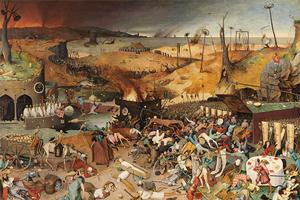Arts
In the World of Art, History Repeats Itself Ximena Varela’s research reveals pandemics’ effects on artists, past and present

This spring, Ximena Varela, director of American University’s Arts Management Program, traveled to England to research one of the first recorded instances of arts management in the Western World: the mystery plays of fourteenth and fifteenth-century York, performed after the Black Death swept through the nation.
“I was researching the first instances of public plays, funded by local businesses, which can be said to be the first seeds of our discipline in the west,” she explains. “These plays were put on stage immediately following the Black Death pandemic.”
While Varela was completing her research, the COVID-19 pandemic started spreading across Europe. Varela was working in the Manuscripts Reading Room of the British Library in London, and then in the York Minster Archives. It was a surreal experience, she says, to spend her days reading about the impact of a deadly pandemic seven centuries earlier, and then to emerge each evening onto twenty-first-century British streets during an entirely new pandemic.
Challenges and Change
Even more startling was Varela’s discovery that history really is repeating itself. She finds significant parallels between the fourteenth-century Black Death plague and the contemporary COVID-19 pandemic. Many of the challenges were the same: illness and death on a massive scale, decimated economies, citizens who defied orders to stay at home, and all the difficulties involved in containing a plague in manufacturing cities that depended on international trade. In fact, the Black Death returned to York six times before finally ending.
Varela points out that there were lessons to be learned. “There were many people who were waiting for the old world to return to the way it was before the Black Death occurred. But the people who thrived afterwards were those who realized that the world was going to change and would need creative solutions.”
As Varela continued her research, she discovered a gap in the historical stories. Though she read many narratives about wealthy noblemen during the Black Death, she found very little information about individual artists.
Again, she saw the parallels between past and present. “Seven hundred years later, things are the same,” she says. “Today, we’ve heard a lot about big art institutions like the Kennedy Center and major orchestras, and we think they will be okay after the pandemic. But we know very little about what will happen to individual artists and how the crisis will affect their lives and work.”
COVID-19 Art Stories
Varela became interested in seeing what had happened to artists and organizations, and their connection to the public after each of the great pandemics: the Black Death, The Great Plague of London, the Spanish Flu, and COVID-19.
“I have been researching what impact they had in common immediately after the pandemic hit, and then over time,” she explains. “It struck me that one of the things we don’t know much about in the earlier ones (especially the Black Death) was how the pandemics impacted individual artists’ lives. We know how pandemics shaped art and society, but we know much less about the stories of the artists themselves.”
Varela began cataloging artists' experiences surrounding the current COVID-19 pandemic — stories of what it feels like to be an artist right now. She has launched a database and website, COVID-19 Art Stories, which is gathering personal stories from artists around the world. The project formed a four-week partnership with Creative Generation, a major global initiative supporting the creative generation worldwide, and which is fostering the creation of new art during the pandemic.
“I want to document the personal, individual stories of artists, but I also want to make them feel less alone.” She has been reaching out to artists across the world, and she says that the website will continue at least until the pandemic ends. “Over time, I want to go back and talk to these artists again,” she says. “I want to know what they will be doing in six months, in a year, and how their perspectives may have changed.”
Lessons Learned
When Varela is asked about what lessons can be learned from previous pandemics, she says that they typically bring about major changes in society, including the way people relate to each other. After the Black Death, major social changes occurred, with improved conditions for the lower classes, diminished powers for the church, migration from rural areas to cities, and the end of serfdom.
“Pandemics affect everyone and make us feel like this is the end of the world,” she says. “But if we look back, we will see that we can’t lose hope. The world continues, art continues, and artists continue to build beautiful things.”
